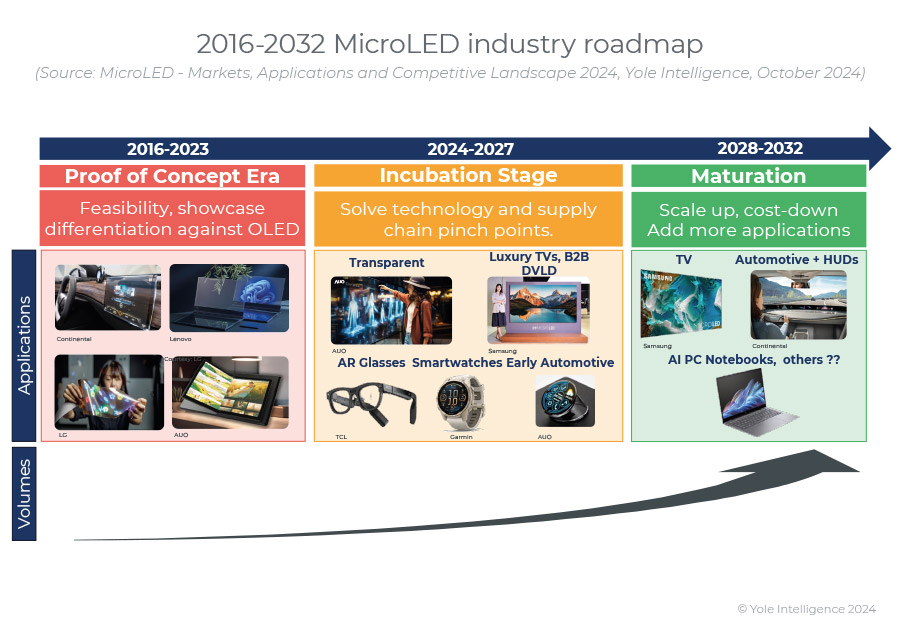In the first half of this year, Apple broke the news that it would cancel the development of Micro LED Apple Watch, and as soon as this news came out, the industry was not optimistic about Micro LED technology, and also made its partner LG Display bear a lot of silent costs, including the purchase of Micro LED-related patent fees and transfer costs of production equipment. According to industry analysis, the main reasons for Apple's cancellation of the development of MicroLED smartwatches include the following:
The cost is too high: Apple found that the production cost of MicroLED screens was too high and not cost-effective. Although this screen has brighter and more vivid visual effects, its manufacturing process requires cutting-edge technology and a complex LED transfer process, resulting in difficult cost reduction.
Technical Challenges: One of the major technical challenges facing MicroLED technology is mass transfer technology, which is the precise placement of millions of tiny LED pixels in a display. The precision requirements of this process are extremely high and not yet fully mature, especially when it comes to improving yield and reducing costs.
Economic viability: Apple evaluated the long-term prospects and short-term challenges of MicroLED technology and decided that the project was not economically viable, especially for applications in small devices such as smartwatches.
Strategic adjustment: Apple may have evaluated the company's long-term strategy and decided to reallocate resources to other projects, such as AI, to focus resources on other promising businesses.
As a revolutionary display technology, the market growth momentum of MicroLED technology is still strong despite the challenges of Apple's withdrawal from related project development. MicroLED technology is widely considered to be a key player in the next generation of display technology due to its excellent performance such as high brightness, high contrast, low power consumption, and high color saturation.

Figure:2016-2032 Micro LED industry roadmap(Source:semiconductortoday)
Technical advantages and market potential
At the heart of MicroLED technology is its tiny LED pixels, which typically range in size from 5-100 microns, enabling extremely high pixel density and resolution. Compared to traditional LCD and OLED, MicroLED technology offers higher energy efficiency, brightness, and longer lifespan. This technology not only provides excellent display results, but also has fast response time and high reliability, which is especially important for applications that require high-speed response and stable display.
Market analysis predicts that the size of the MicroLED market will continue to grow. For example, according to a report released by the China Business Industry Research Institute, the global micro LED market will reach $1.4 billion in 2024 and is expected to continue to grow in the future. In addition, according to Yole's forecast, microLED shipments are expected to reach 450 million units by 2027, showing its huge market potential.
Fields of application
MicroLED technology is used in a wide range of applications, from high-end consumer electronics such as smart watches and TVs to professional applications such as automotive displays and medical imaging. Samsung has already launched TVs that use MicroLED technology, such as "The Wall", demonstrating its potential in large-format display applications. At the same time, MicroLED technology is also expected to be used in the field of automotive displays, providing clear and high-brightness displays while reducing energy consumption.
Industry dynamics and investment trends
Although Apple has withdrawn from the MicroLED project, other industry giants such as Samsung, LG, etc. are still actively investing in the research and development of MicroLED technology. In 2022, the investment in Mini/Micro LED exceeded 70 billion yuan, showing the confidence of the capital market in this technology. In addition, the investment and R&D of Chinese companies in the field of MicroLED are also accelerating, and a number of projects have entered the start-up, post-construction and production stages, showing China's active momentum in this field.
The Challenge
There are still some challenges in the commercialization process of microLED technology, especially the complexity and cost of the manufacturing process. Mass transfer technology is a key challenge, requiring the high-precision transfer and assembly of millions of micro LEDs onto substrates, a time-consuming and costly process. In addition, how to achieve high resolution on larger displays is also a technical challenge.
summary
Despite the challenges, MicroLED technology continues to gain momentum and its potential in the field of display technology is widely recognized. With the continuous advancement of technology and the reduction of costs, it is expected that MicroLED will be more widely adopted in multiple application fields, leading the display technology into a new era.






